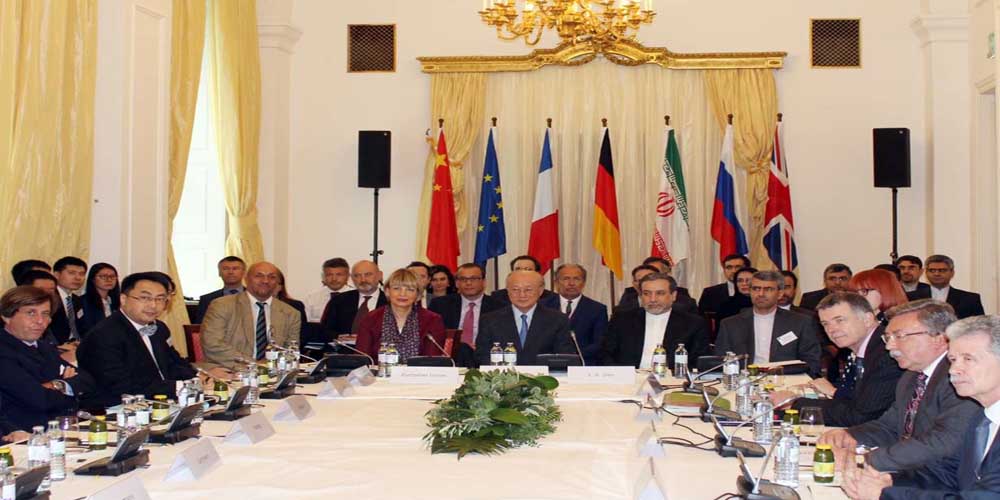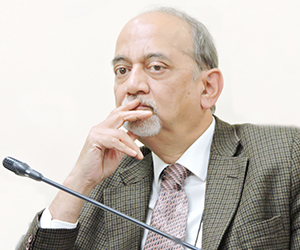A meeting of the Joint Commission established under Joint Comprehensive Plan of Action (JCPOA) took place in Vienna on 6th July. The Joint Commission was set up as the mechanism to resolve any disputes arising out of implementation of the Iran nuclear deal. This was the first such meeting held after US withdrawal from JCPOA announced by President Trump on 9th May. It was convened on Iran’s request. With the exception of UK, all other countries – France, Germany, Russia, China, and Iran - were represented at the level of Foreign Ministers. The UK was represented by the Minister of State for the Middle East, Alistair Burt. The Joint Commission was chaired by EU High Representative Federica Mogherini.
The meeting concluded with reconfirmation by all participants of “their commitment to the full and effective implementation of the nuclear deal.” The Joint Statement recognized that “in return for the implementation by Iran of its nuclear-related commitments, the lifting of sanctions, including the economic dividends arising from it, constitutes an essential part of the JCPOA”. There was no reference to Iran’s missile program, or regional situation, which is cited by President Trump as part of the justification for withdrawing from the nuclear deal. The Joint Statement welcomed the 11th report by the International Atomic Energy Agency of 24 May confirming that Iran is abiding by its nuclear-related commitments.
Preserving the nuclear deal re-confirmed by all the participants involved some crucial elements – continuation of Iran’s oil and gas condensate exports, shipping, insurance, export credit cover and the protection of companies from the extra-territorial effects of US sanctions. The participating states “affirmed” their commitment to these “objectives”. But the crux of the matter is implementation. As the Iranian Foreign Minister Zarif stated after the conference, these steps will have to be implemented before the US sanctions kick-in. This seems rather difficult at the moment.
The Vienna meeting took place against the background of increasing level of rhetoric. On Monday, President Rouhani said that it was ‘unwise’ to think that ‘one day all oil producing countries would export their surplus oil and Iran would be the only country that cannot export its oil”. He added that “Do this if you can and see its consequences.” President Rouhani’s statement was followed by a statement by the Iran Revolutionary Guard Corps (IRGC) chief Major General Mohammad Ali Jafri, “We are hopeful that this plan expressed by our President will be implemented if needed….We will make the enemy understand that either all can use the Strait of Hormuz or no one”.
The Iran nuclear deal did not include an understanding on the regional issues. By raising them, geo-politics has come to the fore. Together, they have impacted oil prices. The OPEC oil basket had reached USD 75.21 per barrel on the eve of the Vienna meeting on 5th July. This is a steep increase over corresponding price a year ago in July 2017, when it stood at USD 46.93 per barrel. This amounted to 60.25 % increase in one year. International oil prices have been influenced by supply disruption in Venezuela and Libya. The trend was reinforced by US decision to withdraw from the Iran nuclear deal. Even before President Trump’s announcement of 9th May, the markets had factored in the increase. Prices went up from USD 70.59 per barrel on 1st May to USD 73.97 on 9th May rising to USD 74.46 the next day.
The OPEC oil ministers’ meet of 22nd June failed to calm the markets. It agreed to lift the production ceiling. But the bench-mark was the November 2016 decision, without taking into account recovery of world economy and oil demand since. In effect, it allowed for an increase of 600,000 barrel per day over present level. As the markets saw it, the decision did not allow for full measure of cut in Iranian oil exports. At present, Iran produces 3.9 million barrels per day, and exports about 2.2 million barrel per day.
President Trump has called for an increase in Saudi production by 2 million barrel per day. The figure roughly corresponds to Iran’s export level. It may not necessarily reflect Saudi’s spare production capacity. They are currently producing around 10.5 million barrels per day of crude oil. It is believed that they can go up to 11 million barrel per day. Going above this level may be technically possible, but difficult to sustain over a period of time. Other Gulf countries can only add marginal quantities.
The US Shale oil production has gone up. But there are problems about bringing it to the market due to pipeline capacity saturation. West Texas Intermediate (WTI), an important benchmark for prices in US market, rose from little above USD 65 per barrel in the beginning of June to USD 73.80 as on 8th July. In fact, the graph is steeper in the US market than OPEC basket price. This points to a huge problem. If volatility in oil prices is difficult to control in US market, which has enormous oil and gas resources, it will be more difficult to curb in other countries, which are far less well endowed.
There are some indications that the US may be willing to discuss options, other than abrupt stoppage of Iranian oil imports. Indo-US relations are very important. India also has a relationship to maintain with Iran. The government’s position was expressed succinctly by the Minister for Petroleum and Natural Gas Shri D Pradhan. As put it, ‘national interest is paramount, and we will align our decision on that”. The impact of US sanctions on Iran will certainly affect Indian market. The Indian oil basket has gone up in last 3 months from USD 69.30 per barrel in April to USD 73.85 barrel in June. A year ago in July 2017, it stood at USD 47.86 per barrel. This amounts to 54.3 percent increase in one year. India as a developing country has much less margin to absorb sharp increase in oil prices, even if supplies can be arranged.
(The author was Indian Ambassador to Iran, and has served in Egypt, Saudi Arabia, and Libya.)
Image Source: http://img8.irna.ir/1397/13970415/82963538/n82963538-72423695.jpg










Post new comment